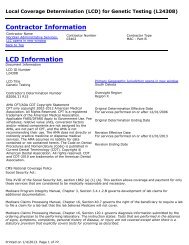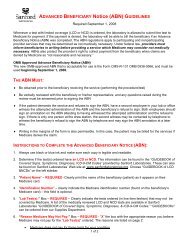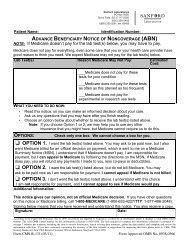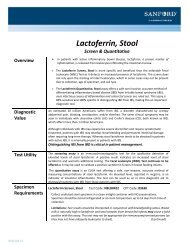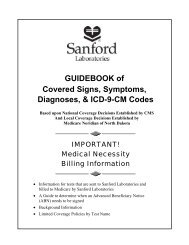aPTT VERSES HEPARIN ANTI-XA - Sanford Laboratories
aPTT VERSES HEPARIN ANTI-XA - Sanford Laboratories
aPTT VERSES HEPARIN ANTI-XA - Sanford Laboratories
You also want an ePaper? Increase the reach of your titles
YUMPU automatically turns print PDFs into web optimized ePapers that Google loves.
ADDRESS SERVICE REQUESTED<br />
ADA Now Recommends HgbA1c to Diagnose<br />
and Screen for Diabetes<br />
4<br />
Each year the American Diabetic Association (ADA) updates its<br />
Standard of Care Recommendations. One significant change<br />
in the 2010 guidelines is the use of the Hemoglobin A1c<br />
(HgbA1c) assay to diagnose and screen for diabetes. While the<br />
ADA had previously recommended HbA1c only for monitoring<br />
of known diabetics, the ADA now endorses HgbA1c as one<br />
of the options to diagnose diabetes. Other recommended<br />
diagnostic tests include the fasting blood glucose, random<br />
blood glucose, and oral glucose tolerance tests.<br />
HgbA1c, which estimates average glucose levels over the<br />
past 3 months, is used to evaluate diabetic control over time.<br />
Previously, the ADA did not recommend the HgbA1c due to<br />
lack of assay standardization. They now believe that the test<br />
is well-monitored and reproducible in any chemistry platform<br />
certified by the National Glycohemoglobin Standardization<br />
Program (NGSP). Some Point of Care (POC) testing systems<br />
are not certified, however, so the lab should use caution when<br />
selecting testing equipment.<br />
The ADA recommends the following HgbA1c range<br />
guidelines: 1) Values near 5% indicate absence of diabetes,<br />
2) A range of 5.7% to 6.4% identifies increased risk for future<br />
diabetes, 3) > 6.5% diagnosis of diabetes<br />
The HgbA1c test does not require an overnight fast and<br />
while the test may not be as sensitive as the fasting blood<br />
glucose, the ease of testing may facilitate increased<br />
screening for diabetes. Hopefully this will encourage those<br />
in the prediabetic range to make positive lifestyle changes<br />
to ward off diabetes. For a complete review of the new<br />
Recommendations, see http://care.diabetesjournals.org/<br />
content/33/Supplement_1S11.full.<br />
Reviewed by Joel Ziebarth, MD; Associate Medical Director for<br />
<strong>Sanford</strong> <strong>Laboratories</strong>; LCM Pathologists, PC<br />
References:<br />
1. Summary of Revisions for the 2010 Clinical Practice<br />
Recommendation, Diabetes Care, Volume 33, Supplement 1, January<br />
2010.<br />
2. ADA now recommends HgA1c assay to diagnose, screen for<br />
diabetes. http://endocrinetoday.com/print.aspx?rid=59777; Accessed<br />
3/29/2010.<br />
3. American Diabetes Association Revises Diabetes Guidelines.<br />
http://www.medscape.com/viewarticle/714401. Accessed<br />
4/14/2010.



